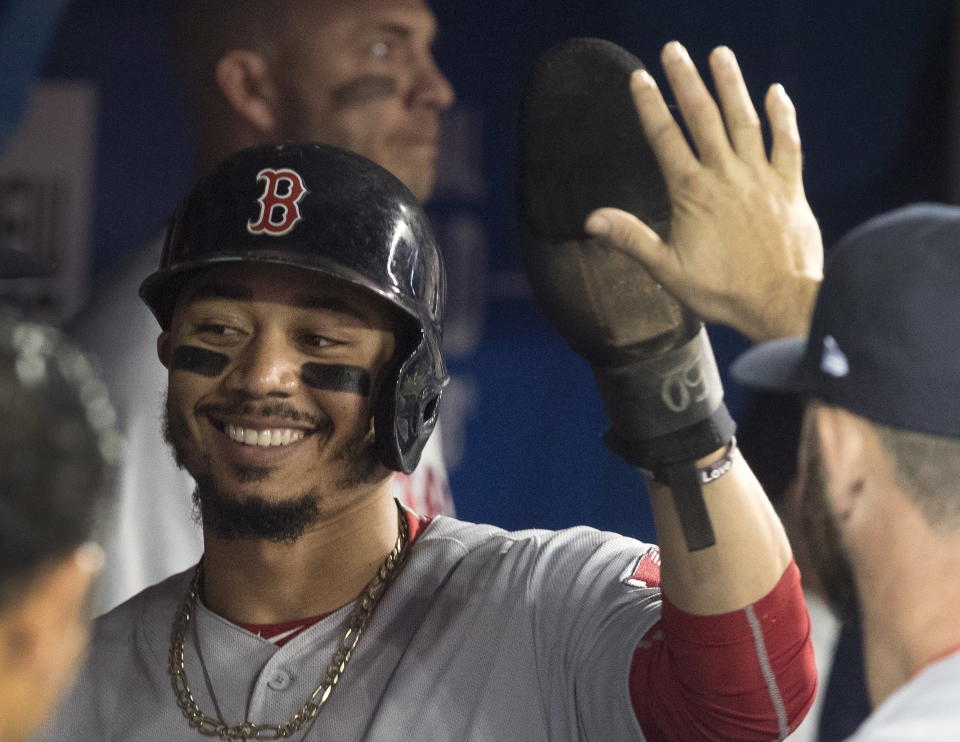Fantasy's luckiest and unluckiest hitters ... Mookie Betts made one of the lists
Imagine a world where the batter’s ability to hit the ball well perfectly correlated to batting average and slugging average. Alas they don’t. But comparing a hitter’s ability to square the baseball to his actual averages helps us isolate really unlucky and lucky hitters.
That may not help us much this year but it can for sure in 2019.
This year, according to MLB stat provider Inside Edge, non-pitchers have a well-hit rate of .165 (that also backs out bunts). And this is of at bats, so if you strike out, that’s an at bat where, of course, you did not hit the ball well. This may seem obvious but the publicly available stats don’t penalize hitters for missing the ball completely (actually worse than not hitting it well).
So we can compare the batter’s well hit rate to that league average and then assume that he will perform according to that ratio the same way relative to the league-wide (non-pitcher) batting(.253) and slugging (.419) averages, entering play on Thursday. Again, the assumption here is that an average well-hit rate should produce an average batting and slugging average (or at least in combination depending on other factors in the hitter’s batted-ball profile).
For example, Mookie Betts (a player I foolishly avoid because of a size bias in favor of the Bryce Harper’s of the world) has a league-leading .287 well-hit rate. That’s insane. To put this in perspective, that earns him an expected batting average today of, hold on to your hats, .434. It adjusts his slugging up to .717. This may sound nuts but note that Betts’ well-hit is 41 points (or 17%) better than the next highest player, his teammate J.D. Martinez (who is hitting .333 vs. his expected .371). If Betts just had Martinez’s luck in converting well-hit rate into batting average, he’d be hitting 17% better or .390. And Martinez’s expected slugging is .613 in this model, lower than his actual .657. Add Martinez’s slugging and batting average up in the well-hit model and it predicts .984. His actual? .990.
Okay, lesson learned with Betts. “Uncle,” I cry. The man is a god and I’m not even being sarcastic. He’s not only lapping everyone in the stat this year but everyone who’s ever been recorded.

So if we take expected batting average and expected slugging and divide by two for one overall number, we can identify the most unlucky hitter in converting well-hit into the stats that show up on the back of the baseball card. Betts is second unluckiest — let that sink in. Here are the leaders and trailers.
That unluckiest 2018 hitter: Matt Olson. His well-hit rate of .217 isn’t translating into either batting average (.236) or slugging (.440). The model predicts .333 and .550. That’s about the average plus slugging he compiled last year, which many are attributing to dumb luck. But his ability to hit the baseball says he’s earned about that this year, too. Olson should be aggressively drafted next year.
Marcell Ozuna looks like he had an outlier 2017, too. This year, he’s only hitting .275 with a .409 slugging. But his well-hit rate of .198 predicts .304 and .502, respectively. That’s pretty much in line with his 2018 projections (in 2017 his average was .312 and he slugged .548). I’ve been rejecting dynasty offers for Ozuna like crazy. Remember, he’s doing this despite being bothered by a sore shoulder all year that has him currently on the DL. He may not have good-hitter stats but he’s hitting the ball well.
Sometimes it takes a while for well-hit rate to translate into the stats that matter in our leagues. Matt Carpenter has been hitting the ball well all year. And he’s all the way up to .270 and .575 in the actual average and slugging stats. But the expectation given that current well-hit of .231 is .354 and .581. Note he’s almost even in slugging and his emphasis on hitting the ball in the air can explain the underachieving in batting average; but that also means his slugging should actually be higher. Since the All-Star Break, Carpenter is hitting .286 with a .690 slugging, which adds up to .976 — slightly more than his full-season expected combined total of .935. This second-half Carpenter is almost legit based on his year-to-date hitting.
Max Kepler is one of the really interesting players. His well-hit of .192 should translate into something like .294 batting average and .486 slugging, yet he sits at .235 and .436. I continue to believe in Kepler and it will cost you nothing next March to find out if he’s just been really unlucky or if there’s something these numbers are missing.
Two players who have actually been lucky in this stat interest me.
Brian Dozier supporters are wondering what they did to deserve this — or what Dozier did to anger the baseball gods. But he’s not unlucky. He’s just not been good. His well hit is a putrid .132. That gives him an expected .202 average and/or .334 slugging. That’s actually way worse than the .228 and .407 he’s actually compiled. The numbers on Dozier have been bad all year.
Amed Rosario has a lot of prospect pedigree but has been just really bad at hitting the baseball. His well-hit rate is .109 and trust me he’s trying to hit the ball into the upper deck regularly. He just can’t do it. His .244 and .366 could be .167/.276. Now he does run well and running speed is a great advantage in defying your well-hit rate. Billy Hamilton, Dee Gordon, Jose Peraza, Tim Anderson and Ender Inciarte are all among the “luckiest” hitters in converting well-hit into batting/slugging average. But some of those guys are slapping at the ball regularly. Rosario takes home-run derby swings but simply can’t connect. He won’t be on any of my teams in 2019.



